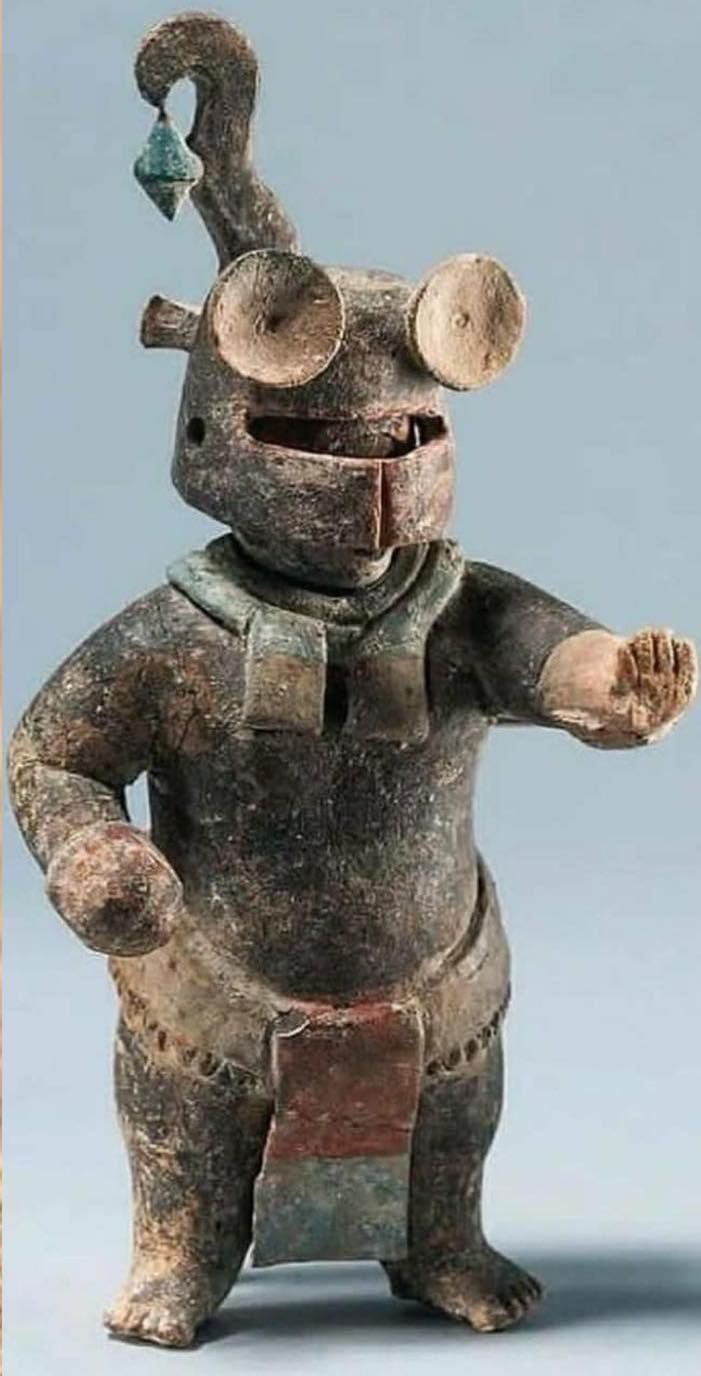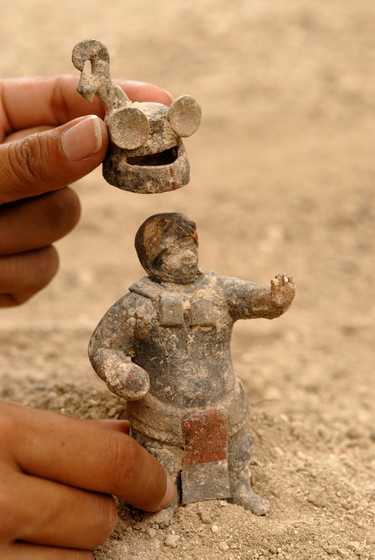Discovery at El Perú-Waka’
In 2006, a groundbreaking archaeological discovery was made in the ancient Maya city of El Perú-Waka’, located in Petén, Guatemala. Among the artifacts uncovered was a stunning 1,500-year-old ceramic figurine featuring a removable helmet, part of a larger assemblage of 23 ceramic figurines arranged in a ritual tableau. These artifacts were found within a royal tomb, designated as Burial 39, shedding light on the ceremonial practices of the ancient Maya.

A Ritual Tableau in Burial 39
The 23 ceramic figurines found in Burial 39 depict a meticulously crafted ceremonial scene. Central to the tableau is a deceased king accompanied by his animal spirit companion, a deer adorned with an oval pendant engraved with the Ik’ symbol. This symbol, representing breath, wind, and life, underscores the Maya’s deep spiritual connection to the forces of nature and the cosmos.

Other figures in the arrangement include a warrior queen, a living king, dancers, scribes, and shamans. Each figure plays a role in the narrative of ritual resurrection and the deceased’s journey to the afterlife. The ensemble captures the Maya’s intricate beliefs about death, renewal, and divine intervention, illustrating their complex cosmology and ceremonial traditions.
The Significance of the Removable Helmet Figurine
Among the figurines, one stands out for its unique craftsmanship and cultural significance: a dwarf boxer with a removable helmet. This figure is believed to represent a performer in ritual ceremonies aimed at invoking life-giving rains, an essential element for agricultural societies like the Maya.
The detachable helmet highlights the symbolic importance of ceremonial attire in Maya rituals. Dwarfs held a special place in Maya culture, often associated with the supernatural and believed to serve as intermediaries between the human and divine realms. The figurine’s intricate design and functionality demonstrate the Maya’s advanced artistry and their ability to imbue everyday objects with profound spiritual meaning.
Insights into Maya Ritual Practices
The discoveries at Burial 39 provide valuable insights into the ceremonial life of the Maya. The figurines reveal a rich tapestry of ritual performances, religious beliefs, and artistic expression. They highlight the Maya’s deep reverence for natural elements, their intricate social hierarchies, and the role of art in conveying spiritual narratives.

The depiction of a ritual resurrection scene speaks to the Maya’s belief in the cyclical nature of life and death. The inclusion of various figures—from a warrior queen to shamans—illustrates the collaborative and hierarchical nature of these ceremonies. Each figurine embodies a distinct role, reinforcing the interconnectedness of their society and spirituality.
Preservation and Cultural Legacy
The artifacts from Burial 39, including the ceramic figurine with the removable helmet, are now housed in the Museo Nacional de Arqueología y Etnología in Guatemala City. These objects continue to be studied and celebrated for their cultural significance, providing a window into one of the most advanced civilizations of the ancient world.
The discovery of these figurines has not only enriched our understanding of Maya art and rituals but also emphasized the importance of preserving cultural heritage. They serve as a testament to the ingenuity and spiritual depth of the Maya, ensuring that their legacy endures in the modern world.
Conclusion
The 1,500-year-old ceramic figurine from El Perú-Waka’ stands as a remarkable example of ancient Maya craftsmanship and religious symbolism. Together with the other figurines from Burial 39, it offers a profound glimpse into the ceremonial life, artistic mastery, and cosmological beliefs of the Maya civilization. These artifacts continue to inspire awe and provide invaluable insights into one of history’s most enigmatic cultures.

